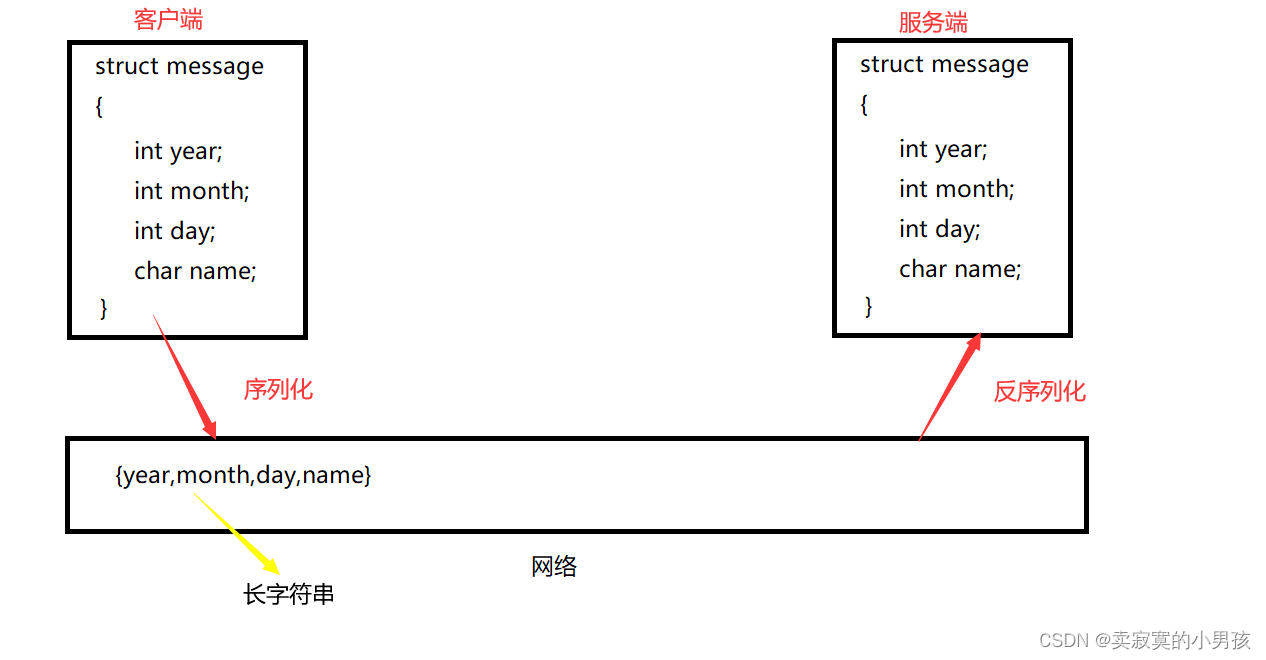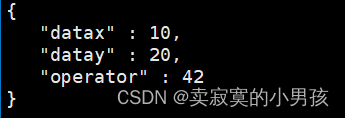-
http协议(序列化与反序列化)
1.序列化与反序列化的过程
如果客户端的数据是一个结构体,这个结构体要发送给服务端。在网络传输的过程中需要将这个结构体转化成字符串,这个过程称为序列化。而数据由字符串转化成结构体再被服务端接收的过程,称为反序列化过程。
结构化的过程其实就是一种协议的体现

2.序列化的原因
1.结构化的数据不利于网络的传输(为了应用层网络通信的方便)。
2.为了方便上层使用内部成员,将应用层和网络进行了解耦。
我们之前做的tcp和UDP通信没有做任何序列化与反序列化。可以json等组件来实现序列化与反序列化。3.json实现序列化
3.1安装json
yum install -y jsoncpp-devel
安装后我们可以在/usr/include/jsoncpp/json找到安装的头文件。
json是一款实现序列化和反序列化的组件。假设我们要实现一个网络版的计算器,客户端发送与服务端发送的结构体如下:#includeusing namespace std; typedef struct request { int x; int y; char op; } request_t; typedef struct response { int code; // code(0)表示成功,code(-1)表示除以0,code(-2)表示对0取模 int result; } response_t; - 1
- 2
- 3
- 4
- 5
- 6
- 7
- 8
- 9
- 10
- 11
- 12
- 13
3.2json的使用
3.2.1序列化使用
1.首先建立Value对象,使用其来接收结构体中的值。
2.使用Writer对象的write方法,将root对象写入字符串中,即可形成一个序列化的字符串。形成的序列化字符串有我们新增的key的内容,在反序列化的时候可以拿掉。request_t req={10,20,'*'}; Json::Value root;//可以承载任何对象,json是一种KV式的序列化方案 root["datax"]=req.x; root["datay"]=req.y; root["operator"]=req.op; Json::StyledWriter writer; string json_string=writer.write(root); cout<<json_string<<endl; return 0;- 1
- 2
- 3
- 4
- 5
- 6
- 7
- 8
- 9
拿到的字符串是:

3.2.2反序列化的过程
1.首先建立Value对象与Reader对象。
2.使用Reader对象的parse方法,将Value对象与字符串相关联。
3.使用Value对象的KV结构来对结构体赋值。string json_string=R"({"datax":10,"datay":20,"operator":42})"; cout<<json_string<<endl; Json::Value root; Json::Reader reader; reader.parse(json_string,root);//将root对象与要反序列化的字符串关联 request_t req; req.x=root["datax"].asInt(); req.y=root["datay"].asInt(); req.op=(char)root["operator"].asInt(); cout<<req.x<<req.y<<req.op<<endl;- 1
- 2
- 3
- 4
- 5
- 6
- 7
- 8
- 9
- 10
3.实现网络版本的计算器
3.1指定协议与序列化反序列化
制定协议的过程,其实就是规定服务端与客户端的结构化数据的结构是什么,比如,我们规定客户端发送的数据的格式和服务端接收数据的格式:
#include#include using namespace std; typedef struct request { int x; int y; char op; } request_t; typedef struct response { int code; // code(0)表示成功,code(-1)表示除以0,code(-2)表示对0取模 int result; } response_t; string SerializeRequest(const request_t& req) { Json::Value root; Json::FastWriter writer; root["datax"]=req.x; root["datay"]=req.y; root["operator"]=req.op; string json_string=writer.write(root); return json_string; } void DeserializeRequest(string& json,request_t& out) { Json::Value root; Json::Reader reader; reader.parse(json,root); out.x=root["datax"].asInt(); out.y=root["datay"].asInt(); out.op=(char)root["operator"].asInt(); } string SerializeResponse(const response& res) { Json::Value root; Json::FastWriter writer; root["code"]=res.code; root["result"]=res.result; string json_string=writer.write(root); return json_string; } void DeserializeResponse(string& json,response_t& out) { Json::Value root; Json::Reader reader; reader.parse(json,root); out.code=root["code"].asInt(); out.result=root["result"].asInt(); } - 1
- 2
- 3
- 4
- 5
- 6
- 7
- 8
- 9
- 10
- 11
- 12
- 13
- 14
- 15
- 16
- 17
- 18
- 19
- 20
- 21
- 22
- 23
- 24
- 25
- 26
- 27
- 28
- 29
- 30
- 31
- 32
- 33
- 34
- 35
- 36
- 37
- 38
- 39
- 40
- 41
- 42
- 43
- 44
- 45
- 46
- 47
- 48
- 49
- 50
3.2基本网络通信(采用TCP协议)
#include#include #include #include #include #include #include using namespace std; namespace ns_Sock { class Sock { private: public: static int Socket() { int sock = socket(AF_INET, SOCK_STREAM, 0); if (sock < 0) { cerr << "创建套接字失败" << endl; exit(-2); } else { return sock; } } static int Listen(int sock) { if(listen(sock,5)<0) { cerr<<"listen error"<<endl; exit(-3); } } static int Accept(int sock) { struct sockaddr_in peer; socklen_t len=sizeof(peer); int fd=accept(sock,(struct sockaddr*)&peer,&len); if(fd>=0) { return fd; } else { exit(-5); } } static void Bind(int sock,uint16_t port) { sockaddr_in local; local.sin_family=AF_INET; local.sin_port=htons(port); local.sin_addr.s_addr=INADDR_ANY; if(bind(sock,(struct sockaddr*)&local,sizeof(local))<0) { cerr<<"bind error"<<endl; exit(-4); } } static void Connect(int sock,string ip,uint16_t port) { struct sockaddr_in server; memset(&server,0,sizeof(server)); server.sin_family=AF_INET; server.sin_port=htons(port); server.sin_addr.s_addr=inet_addr(ip.c_str()); if(connect(sock,(struct sockaddr*)&server,sizeof(server))==0) { cout<<"connect success!"<<endl; } else { cout<<"connect fail"<<endl; exit(-5); } } }; } - 1
- 2
- 3
- 4
- 5
- 6
- 7
- 8
- 9
- 10
- 11
- 12
- 13
- 14
- 15
- 16
- 17
- 18
- 19
- 20
- 21
- 22
- 23
- 24
- 25
- 26
- 27
- 28
- 29
- 30
- 31
- 32
- 33
- 34
- 35
- 36
- 37
- 38
- 39
- 40
- 41
- 42
- 43
- 44
- 45
- 46
- 47
- 48
- 49
- 50
- 51
- 52
- 53
- 54
- 55
- 56
- 57
- 58
- 59
- 60
- 61
- 62
- 63
- 64
- 65
- 66
- 67
- 68
- 69
- 70
- 71
- 72
- 73
- 74
- 75
- 76
- 77
- 78
- 79
- 80
- 81
3.3通信具体业务
3.3.1服务端
#include "protonol.hpp" #include "Sock.hpp" using namespace ns_Sock; using namespace std; void Usage(string proc) { cout << proc << " port" << endl; } void *HandlerRequest(void *args) { int sock = *(int *)args; delete (int *)args; pthread_detach(pthread_self()); char buffer[1024]; ssize_t s = read(sock, buffer, sizeof(buffer) - 1); request_t req; response_t res = {0, 0}; buffer[s] = 0; string str = buffer; cout << str << endl; DeserializeRequest(str, req); switch (req.op) { case '+': res.result = req.x + req.y; break; case '-': res.result = req.x - req.y; break; case '*': res.result = req.x * req.y; break; case '/': if (req.y == 0) res.code = -1; else res.result = req.x / req.y; break; case '%': if (req.y == 0) res.code = -2; else res.result = req.x % req.y; break; default: res.code = -3; } cout << "code=" << res.code << endl; cout << req.x << req.op << req.y << "=" << res.result << endl; string json_string = SerializeResponse(res); write(sock, json_string.c_str(), json_string.size()); cout << "send an answer" << json_string; // write(sock,&res,sizeof(res)); } int main(int argc, char *argv[]) { if (argc != 2) { Usage(argv[0]); return -1; } uint16_t port = atoi(argv[1]); int listen_sock = Sock::Socket(); Sock::Bind(listen_sock, port); Sock::Listen(listen_sock); while (true) { int sock = Sock::Accept(listen_sock); if (sock > 0) { cout << "get a new link..." << endl; int *pram = new int(sock); pthread_t tid; pthread_create(&tid, nullptr, HandlerRequest, pram); } } }- 1
- 2
- 3
- 4
- 5
- 6
- 7
- 8
- 9
- 10
- 11
- 12
- 13
- 14
- 15
- 16
- 17
- 18
- 19
- 20
- 21
- 22
- 23
- 24
- 25
- 26
- 27
- 28
- 29
- 30
- 31
- 32
- 33
- 34
- 35
- 36
- 37
- 38
- 39
- 40
- 41
- 42
- 43
- 44
- 45
- 46
- 47
- 48
- 49
- 50
- 51
- 52
- 53
- 54
- 55
- 56
- 57
- 58
- 59
- 60
- 61
- 62
- 63
- 64
- 65
- 66
- 67
- 68
- 69
- 70
- 71
- 72
- 73
- 74
- 75
- 76
- 77
- 78
3.3.2客户端
#include"Sock.hpp" #include"protonol.hpp" using namespace std; using namespace ns_Sock; void Usage(string proc) { cout<<proc<<" ip"<<" port"<<endl; } int main(int argc,char* argv[]) { if(argc!=3) { Usage(argv[0]); return -1; } int sock=Sock::Socket(); Sock::Connect(sock,argv[1],atoi(argv[2])); request_t req; memset(&req,0,sizeof(req)); cout<<"Please Enter Data1:#"; cin>>req.x; cout<<"Please Enter Data2:#"; cin>>req.y; cout<<"Please Enter op:#"; cin>>req.op; string json_string=SerializeRequest(req); cout<<json_string<<endl; write(sock,json_string.c_str(),json_string.size()); response_t res; char buffer[1024]; memset(buffer,0,sizeof(buffer)); ssize_t s=read(sock,&buffer,sizeof(buffer)-1); buffer[s]=0; string str=buffer; cout<<str<<endl; DeserializeResponse(str,res); cout<<"code[0:-3]#"<<res.code<<endl; cout<<"result#"<<res.result<<endl; } }- 1
- 2
- 3
- 4
- 5
- 6
- 7
- 8
- 9
- 10
- 11
- 12
- 13
- 14
- 15
- 16
- 17
- 18
- 19
- 20
- 21
- 22
- 23
- 24
- 25
- 26
- 27
- 28
- 29
- 30
- 31
- 32
- 33
- 34
- 35
- 36
- 37
- 38
- 39
- 40
4.总结
我们可以将上面的代码分为三部分,分别是基本通信代码(会话层),序列化反序列化代码(表示层),约定以及业务逻辑代码(应用层)。这些在TCP/IP四层协议中统称为应用层。http协议是应用层协议,因此需要完成以上三个工作。
-
相关阅读:
ServletContext对象
C专家编程 第5章 对链接的思考 5.1 函数库、链接和载入
SpringCloud的服务发现框架 — Eureka入门
spingboot按照依赖包除了maven还有Gradle,两者的区别?
ABAP FB05 清账函数:POSTING_INTERFACE_CLEARING
【原型设计模式详解】C/Java/JS/Go/Python/TS不同语言实现
Linux基础入门到精通之虚拟机网络设置说明
数据湖和数据仓库的区别?
linux 安装nginx
从0到1学会Git(第三部分):Git的远程仓库链接与操作
- 原文地址:https://blog.csdn.net/qq_51492202/article/details/126354327
